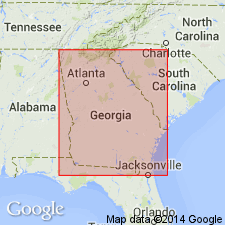
- Usage in publication:
-
- Dug Gap member
- Modifications:
-
- First used
- Dominant lithology:
-
- Sandstone
- Shale
- AAPG geologic province:
-
- Appalachian basin
Summary:
Nomenclature of the Sequatchie Formation in the Clinchport thrust sheet follows usage of Zeigler (1989: Emory Univ. MS thesis). Zeigler divided the Sequatchie into "Ringgold" (base) and Dug Gap members. Dug Gap is 62 m thick and consists of 3 major facies: 1) 0.2 to 2.0-m thick beds of trough cross-bedded, medium to well sorted, coarse-grained, red to white sandstones; 2) poorly bedded, massive, bioturbated, argillaceous, red, coarse-grained sandstone; and 3) gray to red sandy shale with thin bioturbated sandstones and shale intraclast conglomerates, which are interbedded with facies 1 and 2. Unconformably underlies Red Mountain Formation. Age is Late Ordovician.
Source: GNU records (USGS DDS-6; Reston GNULEX).
For more information, please contact Nancy Stamm, Geologic Names Committee Secretary.
Asterisk (*) indicates published by U.S. Geological Survey authors.
"No current usage" (†) implies that a name has been abandoned or has fallen into disuse. Former usage and, if known, replacement name given in parentheses ( ).
Slash (/) indicates name conflicts with nomenclatural guidelines (CSN, 1933; ACSN, 1961, 1970; NACSN, 1983, 2005, 2021). May be explained within brackets ([ ]).

